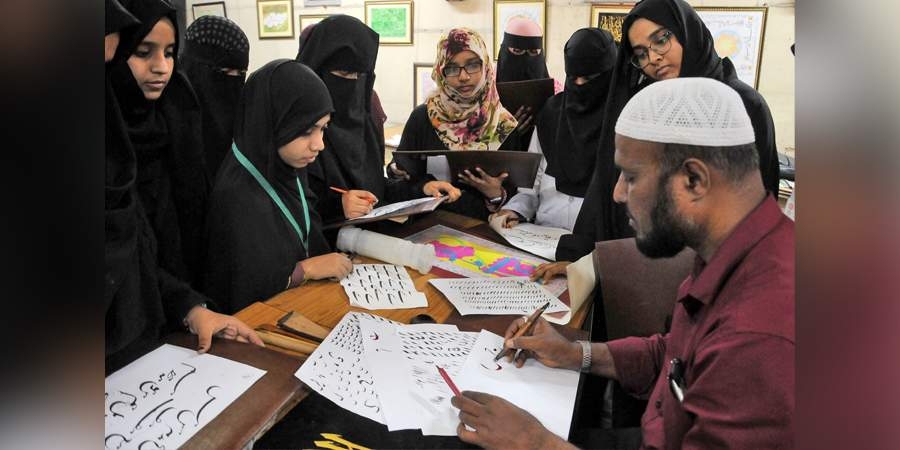Hyderabad, TELANGANA :
In contrast, speaking or writing in Urdu today is often deemed as ‘anti-national’ by multiple sections of the Indian society.

Hyderabad :
Seated on a wooden stool, under a tinted glass chandelier, Mohammed Abdul Gaffar peered over a handmade paper on which he made a slow swish with a reed pen dipped in black ink.
Standing before him, was a group of burqa-clad women, who mirrored the movement of the reed. Over the next 15 minutes, the single stroke on Gaffar’s paper transformed first, into an Urdu alphabet, and then took the form of a decorative Urdu calligraphy verse.
“Calligraphy teaches you patience. It fills one up with peace of mind and also helps in developing your personality,” said Gaffar, a calligraphy artist and teacher.
Gaffar teaches at the Idara-e-Adabiyat-e-Urdu, India’s oldest Urdu calligraphy school — established in 1938, under the patronage of the then-Nizam, Osman Ali Khan Bahadur.
When the school was established, the socio-political scenario of Hyderabad was entirely different: Urdu was the official language of erstwhile Hyderabad State, and its various applications, including calligraphy, found its patronage in the administrative quarters.
“Back then, proficiency in Urdu calligraphy was a necessity for those aspiring government jobs,” said Rafiuddin Qadri, son of the school’s founder, Syed Mohiuddin Qadri Zore. Even candidates trying for police and army jobs needed to be skilled in Urdu calligraphy, Qadri added.
In contrast, speaking or writing in Urdu today is often deemed as ‘anti-national’ by multiple sections of the Indian society.
Case in point, in 2016, Urdu publishers were asked to declare the ‘fealty’ of the content of their works. In that context, Gaffar said that Urdu calligraphy has just now been restricted to being an art form.
From 2002 to 2014, Gaffar fought for the inclusion of Urdu calligraphy in erstwhile Andhra Pradesh government’s school curriculum.
With the formation of Telangana State, where Urdu is the second official language, his fight saw a success and calligraphy was included in school curriculum.
However, teachers for Urdu calligraphy are yet to be appointed by the government. This in spite of several reminders by not just Gaffar but also the ministry of human resource development.
“By not implementing its own order, the government is denying teaching jobs to many,” said Gaffar.
source: http://www.newindianexpress.com / The New Indian Express / Home> Cities> Hyderabad / by Aihik Sur / Express News Service / August 25th, 2019








